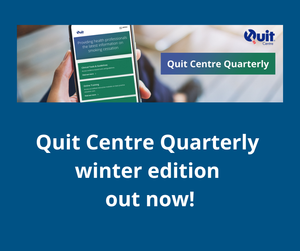52 results
For patients with COPD who smoke, it's never too late to quit.
A recently published comprehensive analysis revealed important benefits of smoking cessation in Chronic Pulmonary Obstructive Disease (COPD). It is never too late to quit, and smoking cessation care is a matter of priority for all patients with COPD who smoke.
News
Quit Centre Quarterly Newsletter - November 2025
The spring edition of Quit Centre Quarterly is out now and it's full of essential information for primary health professionals.
News NewsletterThe importance of smoking and vaping cessation in patients with seasonal asthma
For patients with seasonal (allergic) asthma, smoking and vaping cessation is important. Smoking can worsen respiratory health and trigger symptoms. It's associated with poorer asthma control, reduced lung function, and increased hospitalisations.
NewsImpact of advice to quit smoking on rating of care
A nationwide survey of adults who visited their GP in the past year assessed whether frequency of advice to quit smoking impacts patient rating of care.
News ResearchNicotine replacement therapy aid for the treatment of nicotine vaping dependence
A faster-acting nicotine replacement therapy (NRT) product (mouth spray) has recently been approved by the Therapeutic Goods Administration (TGA) as the first NRT aid for the treatment of tobacco and nicotine vaping dependence by relieving nicotine withdrawal symptoms from smoking and vaping, thereby facilitating cessation in people who smoke and people who vape, who are motivated to quit.
NewsGuidance on supplying therapeutic vapes in pharmacies
The Therapeutic Goods Administration has published regulatory guidance for pharmacies supplying therapeutic vapes.
NewsPharmacy assistant module - smoking and vaping cessation
The pharmacy assistant module on smoking and vaping cessation is now available. Developed in partnership with the Pharmaceutical Society of Australia (PSA), this new module is designed to equip pharmacy assistants with the knowledge and skills they need to support optimal smoking and vaping cessation care.
News
Quit Centre Quarterly Newsletter - June 2025
In this edition of Quit Centre Quarterly read about the National Lung Cancer Screening Program, the role of primary health care nurses in smoking cessation, new TSANZ guidance on vaping, and Quitline support during pregnancy.
